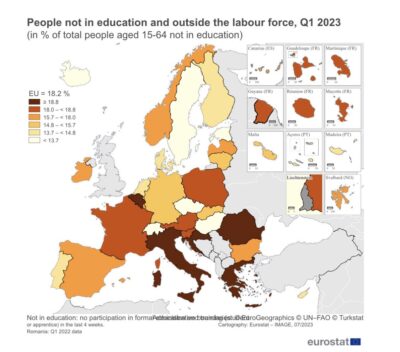A Closer Look at the Statistics Reveals Varied Reasons Behind Their Exclusion
Belgium (Brussels Morning Newspaper) In a concerning revelation, recent data from the European Union Labor Force Survey (EU-LFS) highlights that a substantial 18% of individuals aged 15-64, who are not pursuing education, find themselves excluded from the labor force. These statistics shed light on the complex dynamics and diverse circumstances that keep a significant portion of the population disconnected from job opportunities.
Among the member countries of the European Union, Romania, and Italy have the highest proportion of individuals outside the labor force, encompassing those not involved in education. A striking 25.8% in Romania and 25.6% in Italy fall into this category. Greece follows closely with 22.8%, while Croatia and Belgium register 21.8% and 19.6%, respectively. In contrast, countries such as Sweden, Estonia, and Czechia exhibit significantly lower figures, with rates of 8.3%, 12.3%, and 13.6%, respectively.

Delving deeper into the data, the EU-LFS provides insights into the reasons behind the exclusion of these individuals from the labor force. Out of the 44 million people identified in this category during the first quarter of 2023, a staggering 75.5% expressed no interest in seeking employment and demonstrated a lack of motivation to work. However, a substantial 20.3% indicated their desire to work but were not actively searching for suitable job opportunities. Additionally, 2.8% were actively seeking employment but were not available immediately, while 1.2% had secured jobs but were awaiting the commencement of their employment.
A closer examination of the statistics reveals the underlying factors that contribute to labor force exclusion. Retirement emerged as the primary reason, with 21.1% of individuals outside the labor force citing it as their motivation for not seeking employment. Another significant proportion, 20.7%, attributed their absence from the labor force to illness or disability. Additionally, 18.2% pointed to caregiving responsibilities or other family-related reasons as the cause of their detachment.
The implications of these statistics are profound, necessitating a deeper understanding of the challenges surrounding labor force participation. While some individuals consciously choose retirement or face physical limitations due to illness or disability, the data suggests that a considerable number of capable and willing workers struggle to secure suitable employment or encounter obstacles that impede their entry into the job market.
As policymakers and stakeholders analyze these findings, it becomes evident that targeted interventions are essential to address the challenges faced by individuals not involved in education and outside the labor force. By acknowledging the reasons behind their exclusion and implementing strategies to create more inclusive and accessible job markets, it is possible to foster economic growth and improve the overall well-being of the population.
The data presented by the EU-LFS for the first quarter of 2023 serves as a stark reminder of the hidden challenges faced by a significant portion of the population. With 18% of individuals falling into this category across the European Union, urgent attention and concerted efforts are required to rectify this situation. Through comprehensive understanding and proactive measures, society can pave the way for a more inclusive future, where opportunities abound for all, regardless of their circumstances.
Infographic: People not in education and outside the labor force in Q1 2023, in % of total people not in education and outside the labor force, aged 15-64; by reason, EU
Read more at Europa.eu



